Permeability Evolution of Shale during High-Ionic-Strength Water Sequential Imbibition
Abstract
:1. Introduction
2. Materials and Experimental
2.1. Shale Sample
2.2. Composition of Aqueous Solutions
2.3. Fracture Roughness Measurement
2.4. Micro-CT Scan Analysis
2.5. SEM-EDS Analysis
2.6. Experimental Setup (Former Core-Flooding System)
2.7. Sequential HISW Imbibition Experimental Procedure
3. Results and Discussion
3.1. Fracture Roughness Profile
3.2. HISW Sequential Imbibition Experiments
3.2.1. Solution #1 Imbibition Experiments
3.2.2. Solution #2 and Solution #3 Sequential Imbibition Experiments
4. Conclusions
Author Contributions
Funding
Data Availability Statement
Acknowledgments
Conflicts of Interest
References
- Cheng, W.; Jin, Y.; Chen, M. Reactivation Mechanism of Natural Fractures by Hydraulic Fracturing in Naturally Fractured Shale Reservoirs. J. Nat. Gas Sci. Eng. 2015, 23, 431–439. [Google Scholar] [CrossRef]
- AL-Bazali, T. The Impact of Water Content and Ionic Diffusion on the Uniaxial Compressive Strength of Shale. Egypt. J. Pet. 2013, 22, 249–260. [Google Scholar] [CrossRef]
- Aksu, I.; Bazilevskaya, E.; Karpyn, Z.T. Swelling of Clay Minerals in Unconsolidated Porous Media and Its Impact on Permeability. GeoResJ 2015, 7, 1–13. [Google Scholar] [CrossRef]
- Liu, K.; Sheng, J.J. Experimental Study of the Effect of Stress Anisotropy on Fracture Propagation in Eagle Ford Shale under Water Imbibition. Eng. Geol. 2019, 249, 13–22. [Google Scholar] [CrossRef]
- Liu, B.; Song, Y.; Zhu, K.; Su, P.; Ye, X.; Zhao, W. Mineralogy and Element Geochemistry of Salinized Lacustrine Organic-Rich Shale in the Middle Permian Santanghu Basin: Implications for Paleoenvironment, Provenance, Tectonic Setting and Shale Oil Potential. Mar. Pet. Geol. 2020, 120, 104569. [Google Scholar] [CrossRef]
- Liu, B.; Liang, Y.; Ito, T. Numerical Study on Micro-Cracks and Permeability Changes Linked to Clay Swelling after Fracturing in Shale Rock. J. Pet. Sci. Eng. 2022, 217, 110847. [Google Scholar] [CrossRef]
- Langmuir, D. Aqueous Environmental Geochemistry; Pearson: Upper Saddle River, NJ, USA, 1997; ISBN 9780023674129. [Google Scholar]
- Madsen, F.T.; Müller-Vonmoos, M. The Swelling Behaviour of Clays. Appl. Clay Sci. 1989, 4, 143–156. [Google Scholar] [CrossRef]
- Dehghanpour, H.; Zubair, H.A.; Chhabra, A.; Ullah, A. Liquid Intake of Organic Shales. Energy Fuels 2012, 26, 5750–5758. [Google Scholar] [CrossRef]
- Zeng, L.; Chen, Y.; Lu, Y.; Lau, H.C.; Hossain, M.M.; Saeedi, A.; Xie, Q. Interpreting Water Uptake by Shale with Ion Exchange, Surface Complexation, and Disjoining Pressure. Energy Fuels 2019, 33, 8250–8258. [Google Scholar] [CrossRef]
- Yang, R.; Guo, X.; Yi, J.; Fang, Z.; Hu, Q.; He, S. Spontaneous Imbibition of Three Leading Shale Formations in the Middle Yangtze Platform, South China. Energy Fuels 2017, 31, 6903–6916. [Google Scholar] [CrossRef]
- Zeng, L.; Chen, Y.; Hossain, M.M.; Saeedi, A.; Xie, Q. Wettability Alteration Induced Water Uptake in Shale Oil Reservoirs: A Geochemical Interpretation for Oil-Brine-OM Interaction during Hydraulic Fracturing. Int. J. Coal Geol. 2019, 213, 103277. [Google Scholar] [CrossRef]
- Takeda, M.; Hiratsuka, T.; Ito, K.; Finsterle, S. Development and Application of a Chemical Osmosis Simulator Based on TOUGH2. In Proceedings of the TOUGH Symposium 2012, Berkeley, CA, USA, 17–19 September 2012. [Google Scholar]
- Roshan, H.; Ehsani, S.; Marjo, C.E.; Andersen, M.S.; Acworth, R.I. Mechanisms of Water Adsorption into Partially Saturated Fractured Shales: An Experimental Study. Fuel 2015, 159, 628–637. [Google Scholar] [CrossRef]
- Zolfaghari, A.; Dehghanpour, H.; Noel, M.; Bearinger, D. Laboratory and Field Analysis of Flowback Water from Gas Shales. J. Unconv. Oil Gas Resour. 2016, 14, 113–127. [Google Scholar] [CrossRef]
- Fritz, S.J.; Marine, I.W. Experimental Support for a Predictive Osmotic Model of Clay Membranes. Geochim. Et Cosmochim. Acta 1983, 47, 1515–1522. [Google Scholar] [CrossRef]
- AL-Bazali, T. A Novel Experimental Technique to Monitor the Time-Dependent Water and Ions Uptake When Shale Interacts with Aqueous Solutions. Rock Mech. Rock Eng. 2012, 46, 1145–1156. [Google Scholar] [CrossRef]
- Wang, F.; Pan, Z.; Zhang, S. Impact of Chemical Osmosis on Water Leakoff and Flowback Behavior from Hydraulically Fractured Gas Shale. J. Pet. Sci. Eng. 2017, 151, 264–274. [Google Scholar] [CrossRef]
- Morsy, S.; Sheng, J. Effect of water salinity on shale reservoir productivity. Adv. Pet. Explor. Dev. 2014, 8, 9–14. [Google Scholar] [CrossRef]
- Liu, K.; Sheng, J.J. Experimental Study of the Effect of Water-Shale Interaction on Fracture Generation and Permeability Change in Shales under Stress Anisotropy. J. Nat. Gas Sci. Eng. 2022, 100, 104474. [Google Scholar] [CrossRef]
- Qian, B.; Zhu, J.; Yang, H.; Liang, X.; Yin, C.; Shi, X.; Li, D.; Li, J.; Fang, H. Experiments on Shale Reservoirs Plugs Hydration. Pet. Explor. Dev. 2017, 44, 652–658. [Google Scholar] [CrossRef]
- Wang, Q.; Lyu, C.; Cole, D.R. Effects of Hydration on Fractures and Shale Permeability under Different Confining Pressures: An Experimental Study. J. Pet. Sci. Eng. 2019, 176, 745–753. [Google Scholar] [CrossRef]
- Zhang, S.; Sheng, J.J. Effects of Salinity and Confining Pressure on Hydration-Induced Fracture Propagation and Permeability of Mancos Shale. Rock Mech. Rock Eng. 2017, 50, 2955–2972. [Google Scholar] [CrossRef]
- Ewy, R.T.T.; Stankovic, R.J.J. Shale Swelling, Osmosis, and Acoustic Changes Measured under Simulated Downhole Condition. SPE Drill. Complet. 2010, 25, 177–186. [Google Scholar] [CrossRef]
- Lu, Y.; Zeng, L.; Jin, Y.; Chen, G.; Ren, J.; Lau, H.C.; Xie, Q. Effect of Shale Anisotropy on Hydration and Its Implications for Water Uptake. Energies 2019, 12, 4225. [Google Scholar] [CrossRef]
- Xu, S.; Gou, Q.; Hao, F.; Zhang, B.; Shu, Z.; Zhang, Y. Multiscale Faults and Fractures Characterization and Their Effects on Shale Gas Accumulation in the Jiaoshiba Area, Sichuan Basin, China. J. Pet. Sci. Eng. 2020, 189, 107026. [Google Scholar] [CrossRef]
- Bergendahl, J.A.; Grasso, D. Mechanistic Basis for Particle Detachment from Granular Media. Environ. Sci. Technol. 2003, 37, 2317–2322. [Google Scholar] [CrossRef] [PubMed]
- Mohan, K.K.; Vaidya, R.N.; Reed, M.G.; Fogler, H.S. Water Sensitivity of Sandstones Containing Swelling and Non-Swelling Clays. Colloids Surf. A Physicochem. Eng. Asp. 1993, 73, 237–254. [Google Scholar] [CrossRef]
- Zhou, Z.; Abass, H.; Li, X.; Teklu, T. Experimental Investigation of the Effect of Imbibition on Shale Permeability during Hydraulic Fracturing. J. Nat. Gas Sci. Eng. 2016, 29, 413–430. [Google Scholar] [CrossRef]
- Xu, M.; Dehghanpour, H. Advances in Understanding Wettability of Gas Shales. Energy Fuels 2014, 28, 4362–4375. [Google Scholar] [CrossRef]
- Russell, T.; Pham, D.; Neishaboor, M.T.; Badalyan, A.; Behr, A.; Genolet, L.; Kowollik, P.; Zeinijahromi, A.; Bedrikovetsky, P. Effects of Kaolinite in Rocks on Fines Migration. J. Nat. Gas Sci. Eng. 2017, 45, 243–255. [Google Scholar] [CrossRef]
- Zeng, L.; Reid, N.; Lu, Y.; Hossain, M.M.; Saeedi, A.; Xie, Q. Effect of the Fluid–Shale Interaction on Salinity: Implications for High-Salinity Flowback Water during Hydraulic Fracturing in Shales. Energy Fuels 2020, 34, 3031–3040. [Google Scholar] [CrossRef]
- Mehana, M.; Al Salman, M.; Fahes, M. Impact of Salinity and Mineralogy on Slick Water Spontaneous Imbibition and Formation Strength in Shale. Energy Fuels 2018, 32, 5725–5735. [Google Scholar] [CrossRef]
- Rahman, M.K.; Chen, Z.; Rahman, S.S. Modeling Time-Dependent Pore Pressure Due to Capillary and Chemical Potential Effects and Resulting Wellbore Stability in Shales. J. Energy Resour. Technol. 2003, 125, 169–176. [Google Scholar] [CrossRef]
- Bai, T.; Melkoumian, N.; Hashemi, S.; Badalyan, A.; Zeinijahromi, A. Permeability evolution of fractures in shale in the presence of high salinity water. In Proceedings of the 58th US Rock Mechanics/Geomechanics Symposium, Golden, CO, USA, 23–26 June 2024. [Google Scholar]
- Blondes, M.S.; Gans, K.D.; Engle, M.; Kharaka, Y.K.; Reidy, M.E.; Saraswathula, V.; Thordsen, J.J.; Rowan, E.L.; Morrissey, E.A. U.S. Geological Survey National Produced Waters Geochemical Database v2.3 (Superseded by Ver. 3.0, December 2023) 2018. Available online: https://www.sciencebase.gov/catalog/item/64fa1e71d34ed30c2054ea11 (accessed on 18 May 2023).
- Nicot, J.-P.; Gherabati, A.; Darvari, R.; Mickler, P. Salinity Reversal and Water Freshening in the Eagle Ford Shale, Texas, USA. ACS Earth Space Chem. 2018, 2, 1087–1094. [Google Scholar] [CrossRef]
- Macpherson, G.L. Regional Variations in Formation Water Chemistry: Major and Minor Elements, Frio Formation Fluids, Texas. Am. Assoc. Pet. Geol. Bull. 1992, 76, 740–757. [Google Scholar] [CrossRef]
- Warren, J.K. Salt Usually Seals, but Sometimes Leaks: Implications for Mine and Cavern Stabilities in the Short and Long Term. Earth Sci. Rev. 2017, 165, 302–341. [Google Scholar] [CrossRef]
- Carpenter, A.B. Origin and chemical evolution of brines in sedimentary basins. In Proceedings of the SPE Annual Technical Conference and Exhibition? Houston, TX, USA, 1–3 October 1978. [Google Scholar]
- Bredehoeft, J.; Blyth, C.; White, W.; Maxey, G. Possible mechanism for concentration of brines in subsurface formations. Am. Assoc. Pet. Geol. Bull. 1963, 47, 257–269. [Google Scholar]
- Kharaka, Y.K.; Berry, F.A.P. Simultaneous Flow of Water and Solutes through Geological Membranes—I. Experimental Investigation. Geochim. Cosmochim. Acta 1973, 37, 2577–2603. [Google Scholar] [CrossRef]
- Jang, H.-S.; Kang, S.-S.; Jang, B.-A. Determination of Joint Roughness Coefficients Using Roughness Parameters. Rock Mech. Rock Eng. 2014, 47, 2061–2073. [Google Scholar] [CrossRef]
- Tatone, B.S.A.; Grasselli, G. Quantitative Measurements of Fracture Aperture and Directional Roughness from Rock Cores. Rock Mech. Rock Eng. 2012, 45, 619–629. [Google Scholar] [CrossRef]
- Ye, Z.; Ghassemi, A. Injection-induced Shear Slip and Permeability Enhancement in Granite Fractures. J. Geophys. Res. Solid Earth 2018, 123, 9009–9032. [Google Scholar] [CrossRef]
- EVIDENT. Introduction to Surface Roughness Measurement. 2017. Available online: https://www.qualitymag.com/ext/resources/files/white_papers/Olympus/Introduction-to-Surface-Roughness-Guide.pdf?1611866522 (accessed on 21 May 2024).
- Shen, Y.; Ge, H.; Meng, M.; Jiang, Z.; Yang, X. Effect of Water Imbibition on Shale Permeability and Its Influence on Gas Production. Energy Fuels 2017, 31, 4973–4980. [Google Scholar] [CrossRef]
- Yuan, B.; Wang, Y.; Shunpeng, Z. Effect of Slick Water on Permeability of Shale Gas Reservoirs. J. Energy Resour. Technol. 2018, 140, 112901. [Google Scholar] [CrossRef]
- Anbari, A.; Lowry, E.; Piri, M. Estimation of Capillary Pressure in Unconventional Reservoirs Using Thermodynamic Analysis of Pore Images. J. Geophys. Res. Solid Earth 2019, 124, 10893–10915. [Google Scholar] [CrossRef]
- Yang, F.; Hingerl, F.F.; Xiao, X.; Liu, Y.; Wu, Z.; Benson, S.M.; Toney, M.F. Extraction of Pore-Morphology and Capillary Pressure Curves of Porous Media from Synchrotron-Based Tomography Data. Sci. Rep. 2015, 5, 10635. [Google Scholar] [CrossRef] [PubMed]
- Hildenbrand, A.; Schlömer, S.; Krooss, B.M. Gas Breakthrough Experiments on Fine-grained Sedimentary Rocks. Geofluids 2002, 2, 3–23. [Google Scholar] [CrossRef]
- Nicot, J.-P.; Scanlon, B.R.; Reedy, R.C.; Costley, R.A. Source and Fate of Hydraulic Fracturing Water in the Barnett Shale: A Historical Perspective. Environ. Sci. Technol. 2014, 48, 2464–2471. [Google Scholar] [CrossRef] [PubMed]
- Scanlon, B.R.; Reedy, R.C.; Nicot, J.-P. Comparison of Water Use for Hydraulic Fracturing for Unconventional Oil and Gas versus Conventional Oil. Environ. Sci. Technol. 2014, 48, 12386–12393. [Google Scholar] [CrossRef] [PubMed]
- Singh, H. A Critical Review of Water Uptake by Shales. J. Nat. Gas Sci. Eng. 2016, 34, 751–766. [Google Scholar] [CrossRef]
- Al-Bazali, T.M.; Al-Mudh’hi, S.; Chenevert, M.E. An Experimental Investigation of the Impact of Diffusion Osmosis and Chemical Osmosis on the Stability of Shales. Pet. Sci. Technol. 2011, 29, 312–323. [Google Scholar] [CrossRef]
- Ji, L.; Geehan, T. Shale failure around hydraulic fractures in water fracturing of gas shale. In Proceedings of the SPE Canada Unconventional Resources Conference, Calgary, AB, Canada, 5–7 November 2013. [Google Scholar]
- Jordan, M.M.; Sutherland, L.; Johnston, C.J. Online Cleaning of Carbonate Deposits. The Potential and Limitations of a Novel Cleaning Method. In Proceedings of the SPE International Conference on Oilfield Chemistry, The Woodlands, TX, USA, 6–7 December 2021. [Google Scholar]
- Okland, D.; Cook, J. Bedding-related borehole instability in high-angle wells. In Proceedings of the SPE/ISRM rock mechanics in petroleum engineering, Trondheim, Norway, 8–10 July 1998. [Google Scholar]
- Lee, H.; Ong, S.H.; Azeemuddin, M.; Goodman, H. A Wellbore Stability Model for Formations with Anisotropic Rock Strengths. J. Pet. Sci. Eng. 2012, 96–97, 109–119. [Google Scholar] [CrossRef]
- Ma, T.; Chen, P. A Wellbore Stability Analysis Model with Chemical-Mechanical Coupling for Shale Gas Reservoirs. J. Nat. Gas Sci. Eng. 2015, 26, 72–98. [Google Scholar] [CrossRef]
- Li, Y.; Fu, Y.; Tang, G.; She, C.; Guo, J.; Zhang, J. Effect of weak bedding planes on wellbore stability for shale gas wells. In Proceedings of the IADC/SPE Asia Pacific Drilling Technology Conference and Exhibition? Tianjin, China, 9–11 July 2012. [Google Scholar]
- Opedal, N.; Todorovic, J.; Torsæter, M.; Vrålstad, T.; Mushtaq, W. Experimental study on the cement-formation bonding. In Proceedings of the SPE International Conference and Exhibition on Formation Damage Control, Lafayette, LA, USA, 26–28 February 2014. [Google Scholar]
- Stroisz, A.; Gawel, K.; Bjørge, R.; Cerasi, P. Tensile strength of the interface between cement and shale caprock and the mechanism of strength development. In Proceedings of the ARMA US Rock Mechanics/Geomechanics Symposium, New York, NY, USA, 23–26 June 2019. [Google Scholar]
- Bennion, D.B. An Overview of Formation Damage Mechanisms Causing a Reduction in the Productivity and Injectivity of Oil and Gas Producing Formations. J. Can. Pet. Technol. 2002, 41. [Google Scholar] [CrossRef]
- Mantell, M. Recycling and reuse of produced water to reduce freshwater use in hydraulic fracturing operations. In Proceedings of the Technical Workshop on Water Acquisition Modeling: Assessing Impacts Through Modeling and Other Means Conference, Arlington, VA, USA, 4 June 2013. [Google Scholar]
- King, G.E. Thirty years of gas shale fracturing: What have we learned? In Proceedings of the SPE Annual Technical Conference and Exhibition? Florence, Italy, 19–22 September 2010. [Google Scholar]
- Agrawal, S.; Sharma, M.M. Impact of liquid loading in hydraulic fractures on well productivity. In Proceedings of the SPE Hydraulic Fracturing Technology Conference and Exhibition, The Woodlands, TX, USA, 4–6 February 2013. [Google Scholar]
- Wong, R. Swelling and Softening Behaviour of La Biche Shale. Can. Geotech. J. 1998, 35, 206–221. [Google Scholar] [CrossRef]
- Pedlow, J.; Sharma, M. Changes in Shale Fracture Conductivity due to Interactions with Water-Based Fluids. In Proceedings of the SPE Hydraulic Fracturing Technology Conference, The Woodlands, TX, USA, 4–6 February 2014. [Google Scholar]
- Khan, R.A.; Ahmad, H.M.; Murtaza, M.; Abdulraheem, A.; Kamal, M.S.; Mahmoud, M. Impact of Multi-Branched Ionic Liquid on Shale Swelling and Hydration for High Temperature Drilling Applications. In Proceedings of the SPE/IADC Middle East Drilling Technology Conference and Exhibition, Abu Dhabi, United Arab Emirates, 25–27 May 2021. [Google Scholar] [CrossRef]
- Teklu, T.W.; Abass, H.H.; Hanashmooni, R.; Carratu, J.C.; Ermila, M. Experimental Investigation of Acid Imbibition on Matrix and Fractured Carbonate Rich Shales. J. Nat. Gas Sci. Eng. 2017, 45, 706–725. [Google Scholar] [CrossRef]
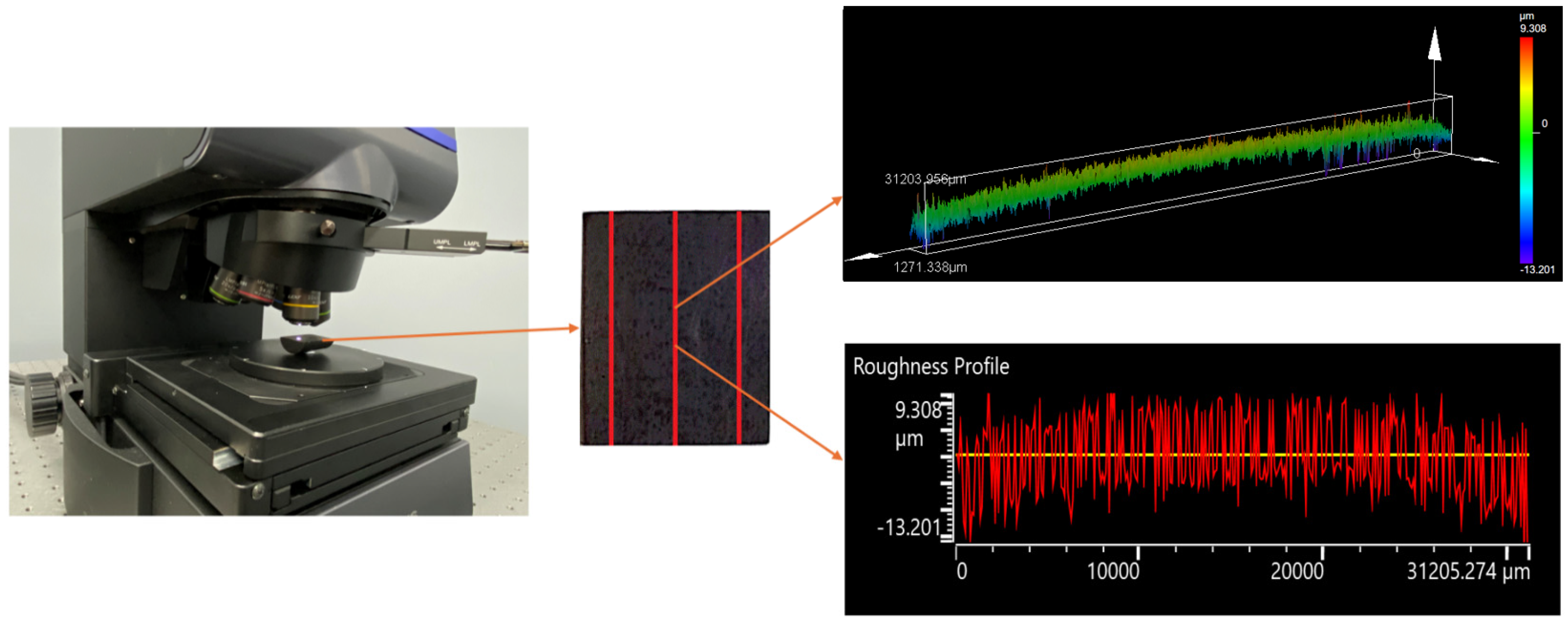
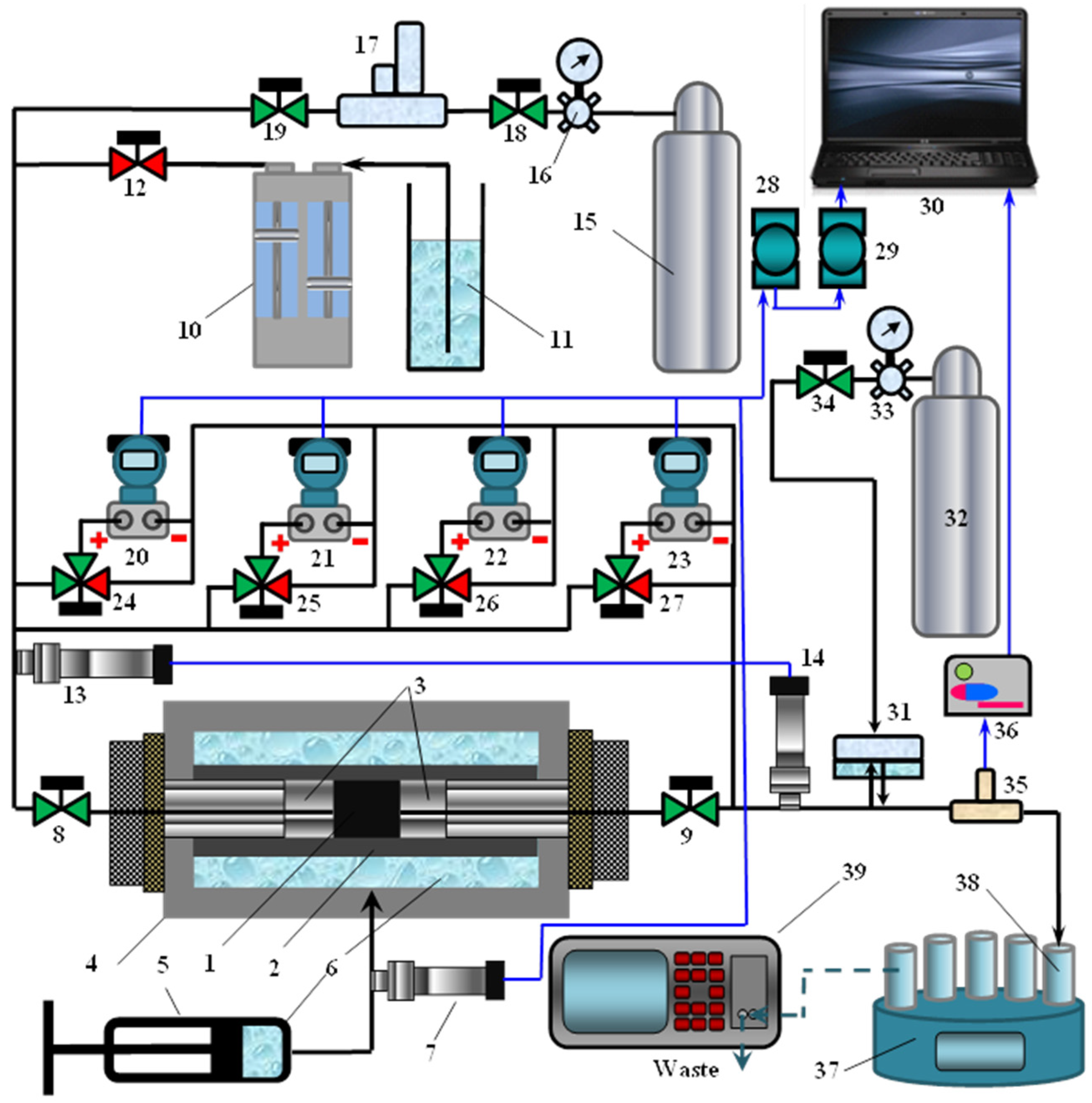


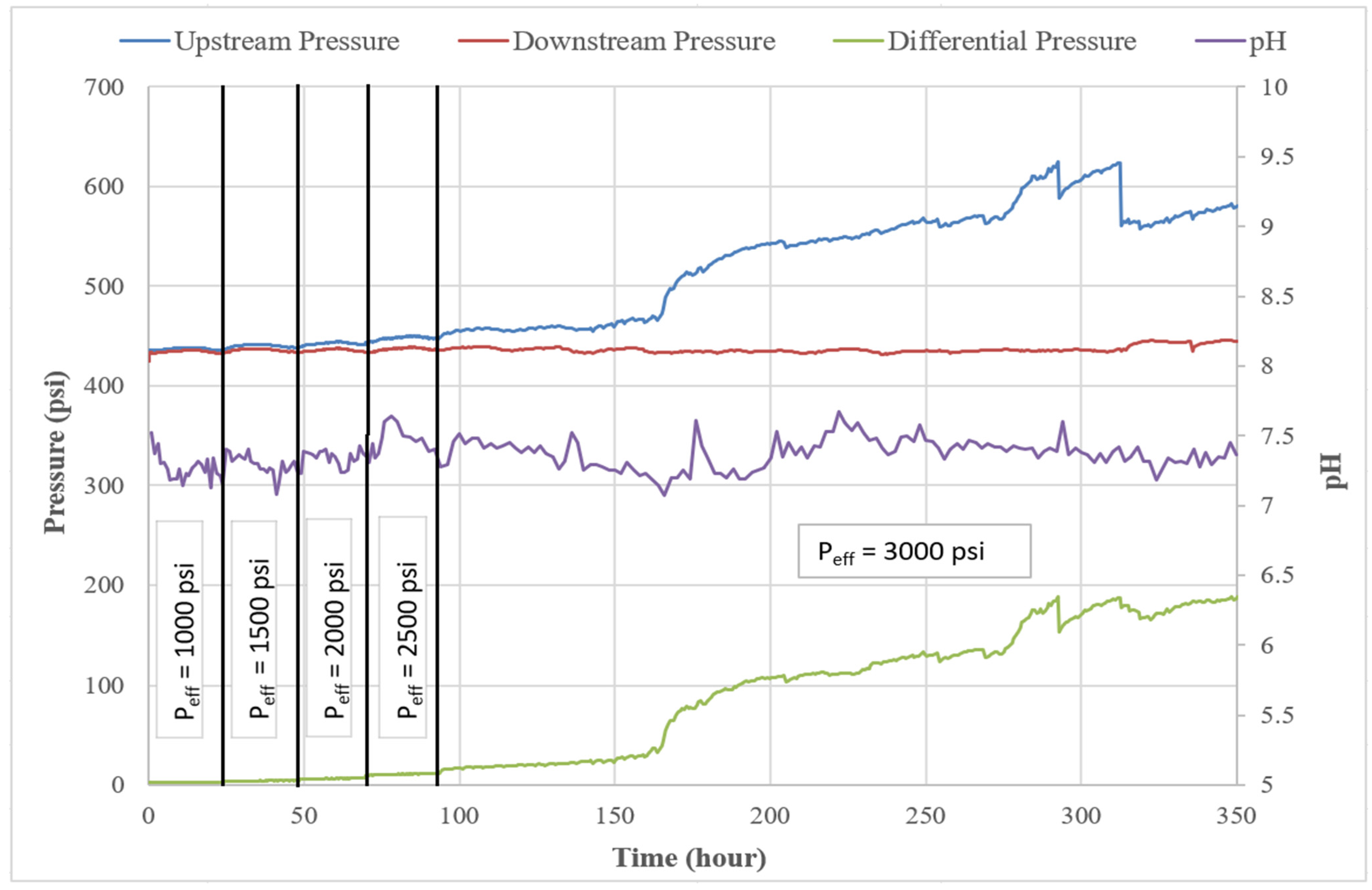
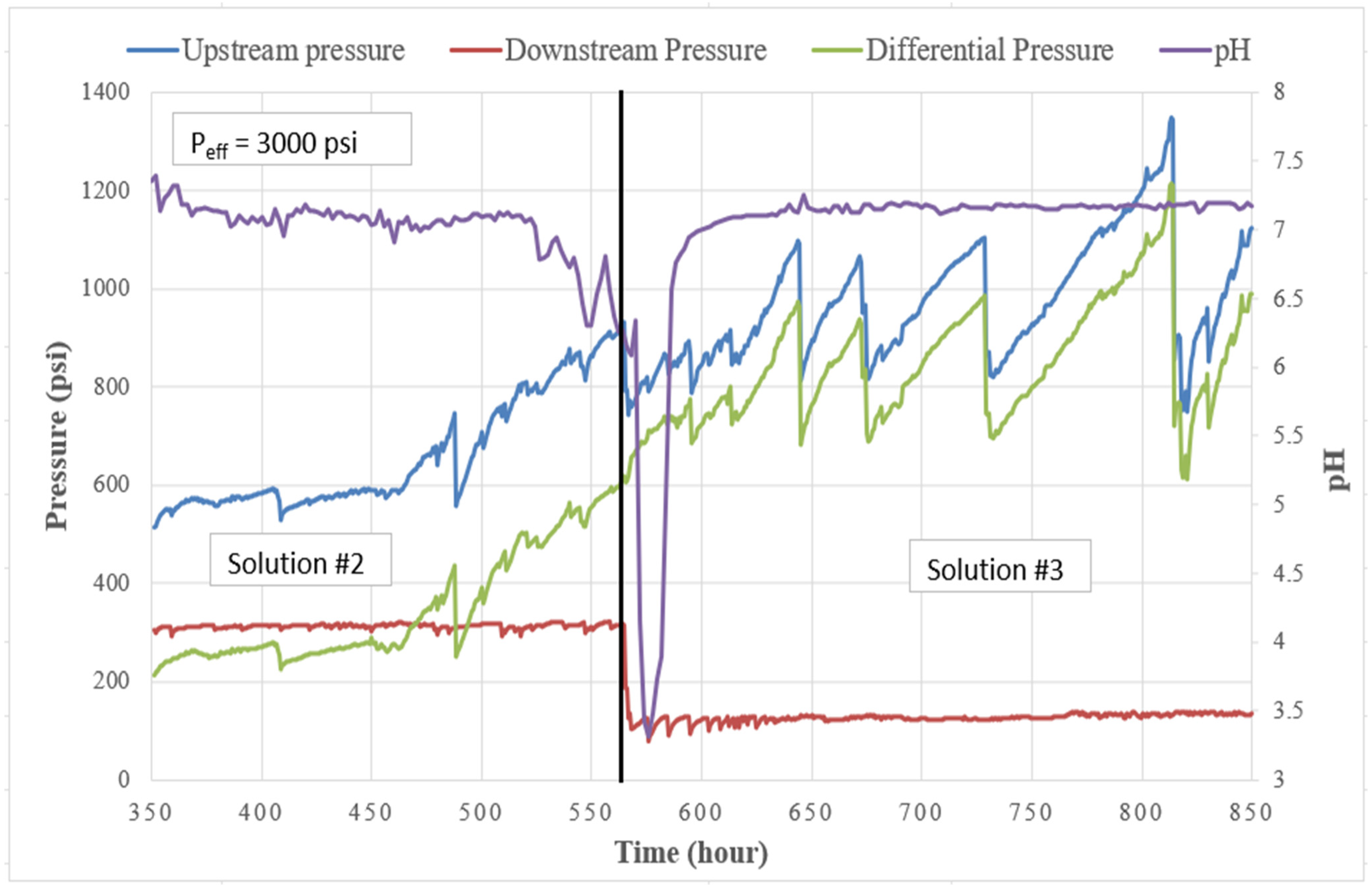
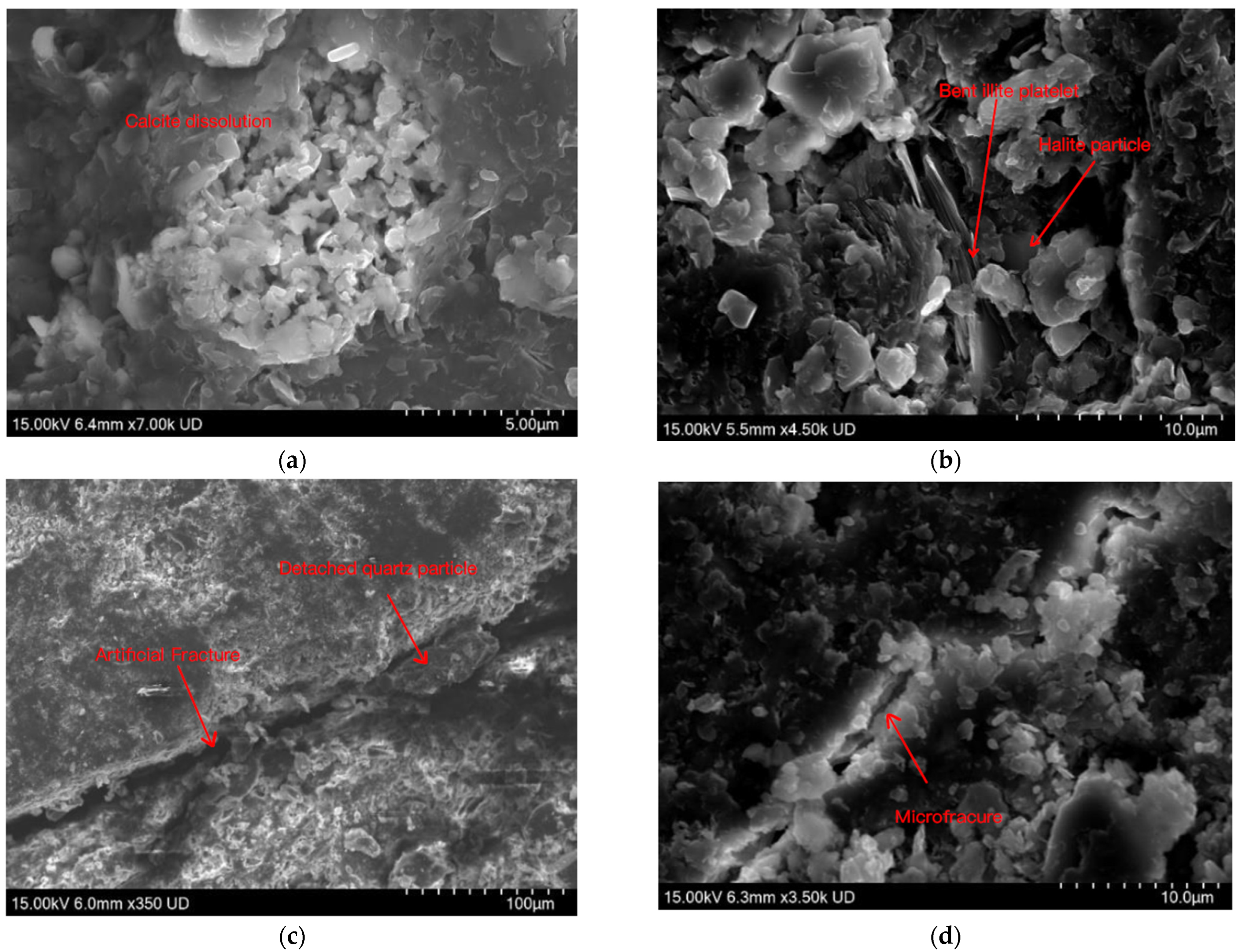
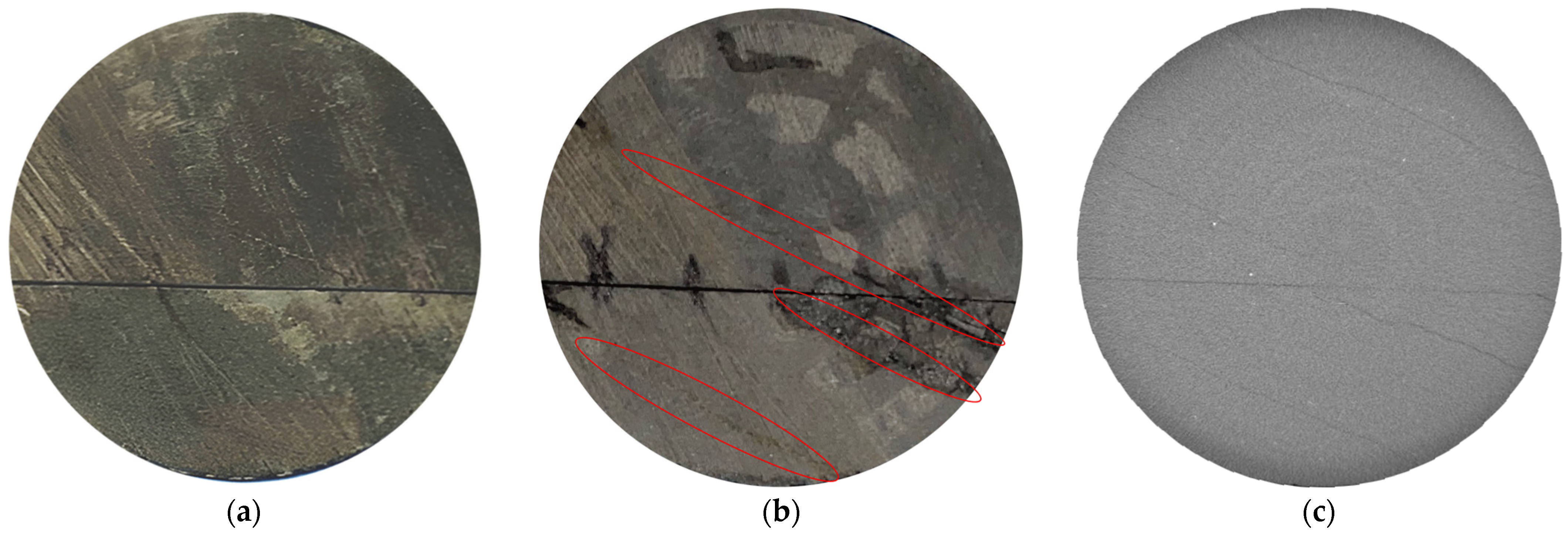

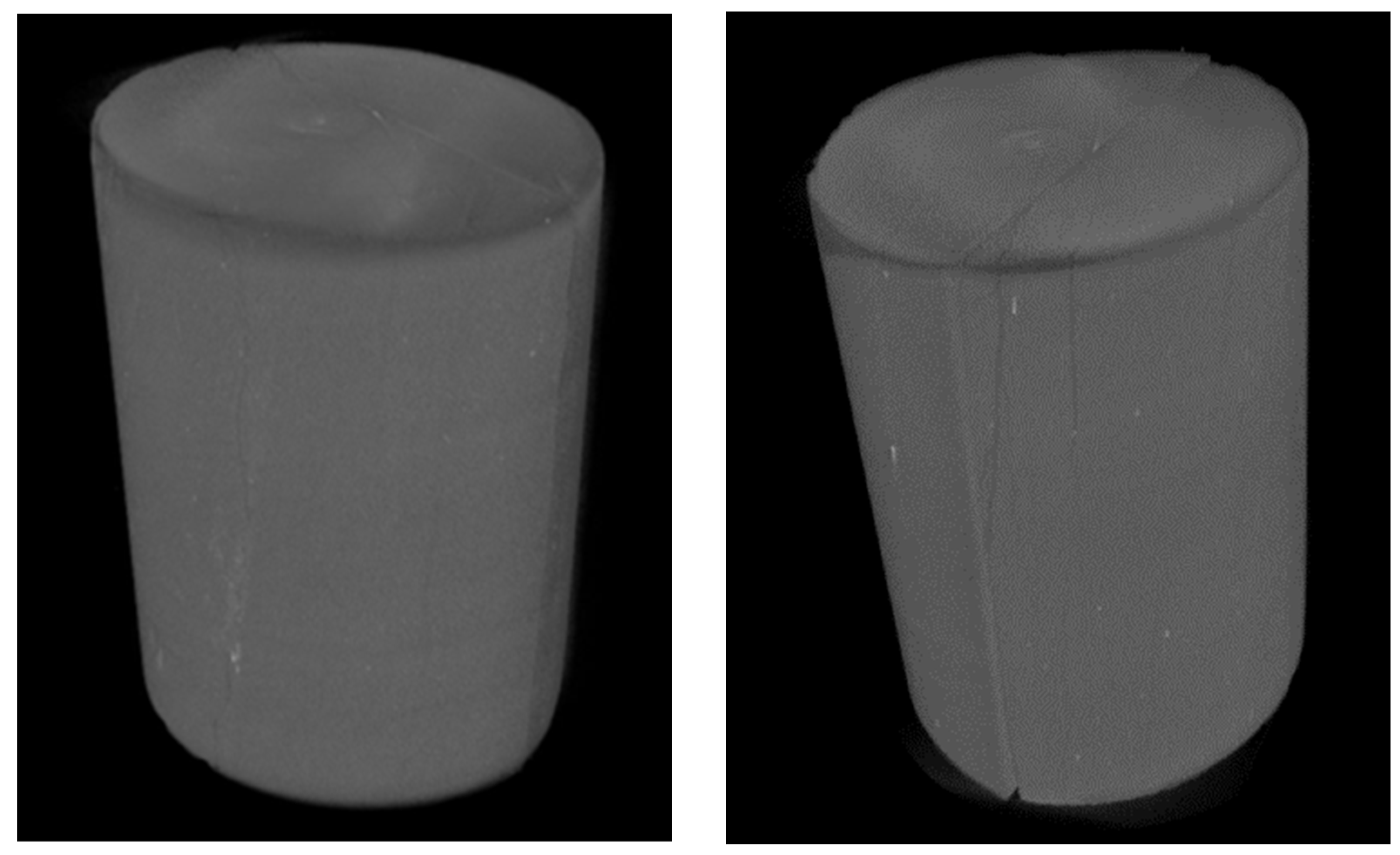
| Compositions | Percentage (%) |
|---|---|
| Quartz | 51.70 |
| Calcite | 26.72 |
| Muscovite | 4.80 |
| Montmorillonite | 3.91 |
| Illite | 9.78 |
| Pyrite | 0.72 |
| TOC | 2.37 |
| Solution #1 | Solution #2 | Solution #3 | |
|---|---|---|---|
| NaCl (wt. %) | 11.25 | 7.3 | 2.91 |
| CaCl2 H2O (wt. %) | 0.37 | 3.67 | 7.34 |
| TDS (ppm) | 115,247 | 100,734 | 84,426 |
| Ionic strength (M) | 2.0 | 2.0 | 2.0 |
| Electrolytic conductivity (mS/cm) | 149 | 132.4 | 116.4 |
| pH | 7.22 | 7.11 | 6.75 |
| Sq (μm) | Sp (μm) | Sv (μm) | Sz (μm) | Sa (μm) |
|---|---|---|---|---|
| 3.56 | 50.64 | 54.53 | 105.66 | 2.63 |
Disclaimer/Publisher’s Note: The statements, opinions and data contained in all publications are solely those of the individual author(s) and contributor(s) and not of MDPI and/or the editor(s). MDPI and/or the editor(s) disclaim responsibility for any injury to people or property resulting from any ideas, methods, instructions or products referred to in the content. |
© 2024 by the authors. Licensee MDPI, Basel, Switzerland. This article is an open access article distributed under the terms and conditions of the Creative Commons Attribution (CC BY) license (https://creativecommons.org/licenses/by/4.0/).
Share and Cite
Bai, T.; Hashemi, S.; Melkoumian, N.; Badalyan, A.; Zeinijahromi, A. Permeability Evolution of Shale during High-Ionic-Strength Water Sequential Imbibition. Energies 2024, 17, 3598. https://doi.org/10.3390/en17143598
Bai T, Hashemi S, Melkoumian N, Badalyan A, Zeinijahromi A. Permeability Evolution of Shale during High-Ionic-Strength Water Sequential Imbibition. Energies. 2024; 17(14):3598. https://doi.org/10.3390/en17143598
Chicago/Turabian StyleBai, Tianhao, Sam Hashemi, Noune Melkoumian, Alexander Badalyan, and Abbas Zeinijahromi. 2024. "Permeability Evolution of Shale during High-Ionic-Strength Water Sequential Imbibition" Energies 17, no. 14: 3598. https://doi.org/10.3390/en17143598
APA StyleBai, T., Hashemi, S., Melkoumian, N., Badalyan, A., & Zeinijahromi, A. (2024). Permeability Evolution of Shale during High-Ionic-Strength Water Sequential Imbibition. Energies, 17(14), 3598. https://doi.org/10.3390/en17143598






